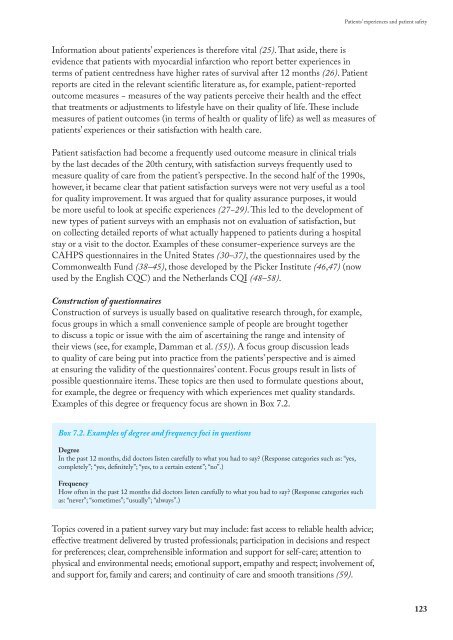Exploring patient participation in reducing health-care-related safety risks
Exploring patient participation in reducing health-care-related safety risks
Exploring patient participation in reducing health-care-related safety risks
Create successful ePaper yourself
Turn your PDF publications into a flip-book with our unique Google optimized e-Paper software.
Information about <strong>patient</strong>s’ experiences is therefore vital (25). That aside, there is<br />
evidence that <strong>patient</strong>s with myocardial <strong>in</strong>farction who report better experiences <strong>in</strong><br />
terms of <strong>patient</strong> centredness have higher rates of survival after 12 months (26). Patient<br />
reports are cited <strong>in</strong> the relevant scientific literature as, for example, <strong>patient</strong>-reported<br />
outcome measures − measures of the way <strong>patient</strong>s perceive their <strong>health</strong> and the effect<br />
that treatments or adjustments to lifestyle have on their quality of life. These <strong>in</strong>clude<br />
measures of <strong>patient</strong> outcomes (<strong>in</strong> terms of <strong>health</strong> or quality of life) as well as measures of<br />
<strong>patient</strong>s’ experiences or their satisfaction with <strong>health</strong> <strong>care</strong>.<br />
Patient satisfaction had become a frequently used outcome measure <strong>in</strong> cl<strong>in</strong>ical trials<br />
by the last decades of the 20th century, with satisfaction surveys frequently used to<br />
measure quality of <strong>care</strong> from the <strong>patient</strong>’s perspective. In the second half of the 1990s,<br />
however, it became clear that <strong>patient</strong> satisfaction surveys were not very useful as a tool<br />
for quality improvement. It was argued that for quality assurance purposes, it would<br />
be more useful to look at specific experiences (27−29). This led to the development of<br />
new types of <strong>patient</strong> surveys with an emphasis not on evaluation of satisfaction, but<br />
on collect<strong>in</strong>g detailed reports of what actually happened to <strong>patient</strong>s dur<strong>in</strong>g a hospital<br />
stay or a visit to the doctor. Examples of these consumer-experience surveys are the<br />
CAHPS questionnaires <strong>in</strong> the United States (30–37), the questionnaires used by the<br />
Commonwealth Fund (38–45), those developed by the Picker Institute (46,47) (now<br />
used by the English CQC) and the Netherlands CQI (48–58).<br />
Construction of questionnaires<br />
Construction of surveys is usually based on qualitative research through, for example,<br />
focus groups <strong>in</strong> which a small convenience sample of people are brought together<br />
to discuss a topic or issue with the aim of ascerta<strong>in</strong><strong>in</strong>g the range and <strong>in</strong>tensity of<br />
their views (see, for example, Damman et al. (55)). A focus group discussion leads<br />
to quality of <strong>care</strong> be<strong>in</strong>g put <strong>in</strong>to practice from the <strong>patient</strong>s’ perspective and is aimed<br />
at ensur<strong>in</strong>g the validity of the questionnaires’ content. Focus groups result <strong>in</strong> lists of<br />
possible questionnaire items. These topics are then used to formulate questions about,<br />
for example, the degree or frequency with which experiences met quality standards.<br />
Examples of this degree or frequency focus are shown <strong>in</strong> Box 7.2.<br />
Box 7 .2 . Examples of degree and frequency foci <strong>in</strong> questions<br />
Degree<br />
In the past 12 months, did doctors listen <strong>care</strong>fully to what you had to say? (Response categories such as: “yes,<br />
completely”; “yes, def<strong>in</strong>itely”; “yes, to a certa<strong>in</strong> extent”; “no”.)<br />
Frequency<br />
How often <strong>in</strong> the past 12 months did doctors listen <strong>care</strong>fully to what you had to say? (Response categories such<br />
as: “never”; “sometimes”; “usually”; “always”.)<br />
Topics covered <strong>in</strong> a <strong>patient</strong> survey vary but may <strong>in</strong>clude: fast access to reliable <strong>health</strong> advice;<br />
effective treatment delivered by trusted professionals; <strong>participation</strong> <strong>in</strong> decisions and respect<br />
for preferences; clear, comprehensible <strong>in</strong>formation and support for self-<strong>care</strong>; attention to<br />
physical and environmental needs; emotional support, empathy and respect; <strong>in</strong>volvement of,<br />
and support for, family and <strong>care</strong>rs; and cont<strong>in</strong>uity of <strong>care</strong> and smooth transitions (59).<br />
Patients’ experiences and <strong>patient</strong> <strong>safety</strong><br />
123



